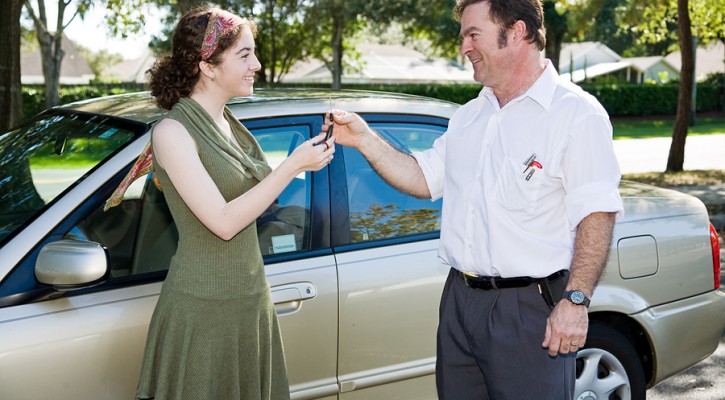Tag Archive: graduated drivers license

Five Tips Before Teens Get Their Drivers License
October 6, 2010
A common rite of passage for teenagers is getting their driver’s license. Before teens get their license, they have to prepare themselves thoroughly. Here are a five tips for teens as they work towards their driver’s license:
1. Study the handbook. It’s surprising what kind of motivation teens have when it comes to studying for their driving test. The written part of the driving exam is pretty much like other tests for classes in school: you have to study to pass. You don’t study, you fail. You never know which part of the driving manual will appear in the exam, so it important to be well versed on the material to increase the chances of passing. If you decide you want to practice more, you can sign up for a drivers license practice test online course. You’ll get to see over 1,500 questions and answers similar to those found on the written driver’s test, along with detailed explanations.
2. Find out about the local GDL laws. Different states have different Graduated Drivers License (GDL) laws, and it’s worth noting that many states have varied age and time of day restrictions, passenger and mobile device limitations, and educational requirements before teens can get a full license. Also, the penalties and ordinances change depending on where you drive. Be familiar with the laws and ordinances for teen drivers for where you live and the places you plan to drive with your teen.
3. Make a covenant with parents. Straight talk and clear guidelines between teen drivers and their parents or guardians will assist teen driver safety. Setting boundaries that teens and parents can agree on will give teens an idea of the responsibility they will be undertaking. A Teen Driving Contract will help to guide and establish the expectations and consequences of driving privileges and behavior.
4. Practice makes perfect. A teen should always insist on getting more practice with their driving. On the other hand, parents and guardians over 21 years-old, should be more than willing to accompany them and teach them how to drive properly, especially in different types of weather and road conditions and environments, including nighttime, rain, and expressway driving. Several states require 50 hours of behind the wheel driving practice as a minimum, before full licensure. To help record this time, use a driving log. A printable version can be found at
5. No, focus makes perfect. Learning to maneuver the vehicle with ease and control is a milestone. But if a teen cannot stay focused, they are not ready to drive alone. This tip works in conjunction with the tips above. Giving each task the required amount of attention will make teen drivers reach their goal of becoming better drivers. Removing distractions to driving and keeping them focused on their interaction with the changing driving environment will not only make getting their license easier, it will help them be a safer driver.
Use these tips to help to set your teen up for success as they embark on preparing for their license. It is an exciting time of new endeavors and more independence. Have fun and be safe!

Graduated Drivers License Laws Around the United States
June 3, 2010
Young drivers in the United Stares are subject to many different laws, regulations and procedures. Many of the rules, regulations, privileges and limitations are similar from state to state but some also differ greatly. It would be overwhelming to compare the rules and regulations young drivers face in all 50 states. It’s easier to compare the policies of a handful of states. Many states differ on age young drivers can obtain their learner’s permits and driver’s licenses; they also differ on nighttime driving and passenger restrictions. Additionally the amount of supervised driving various from state to state and the length of time a young driver needs to have a learner’s permit before they can obtain a driver’s license various as well.
Minimum Age to Obtain a Leaner’s Permit
Many states allow teenagers to get their learner’s permits once they have turned 15. The minimum age to obtain a learner’s permit in Florida, Georgia and Texas is 15. In Colorado and Illinois 15 year olds can obtain their learner’s permits if they are enrolled in drives education. In California, teenagers must be 15 years and 6 months old before they can obtain their learner’s permits. Teenagers in New York are ineligible to obtain their permits until they turn 16.
Requirements to obtain a Driver’s License
After obtaining their learner’s permits young drivers are required to possess their permits for a specific amount of time until they are able to take their road tests (assuming they have reached the minimum age to take the toad test). In California, Texas and New York young drivers are only required to have a permit for six months before they take the road test for their driver’s licenses (or restricted licenses). In Illinois a permit is required for nine months before the road test can be taken. Colorado, Florida and Georgia require young drivers to keep their permits of a minimum of 12 months.
Before young drivers are able to get their licenses they are required to log a specific be amount of time behind the wheel. Most states require that 50 hours of driving time be completed and that 10 or 15 of those hours include nighttime driving. However, Texas only requires that 20 hours of driving being completed. But, at least 10 out of the 20 hours needs to be nighttime driving. Georgia requires that drivers complete at least 40 hours of driving and that at least 6 of the hours are night time driving.
In order to obtain a driver’s license or restricted license most states require that driver’s be at least 16 and have taken driver’s education. In order to get a driver’s license without taking a driver’s education course most states require the drivers to be 17 or 18. New York State issues a junior license to 16 year olds who have held their permits for at least 6 months. If they take driver’s ed they are eligible for their senior licenses at 17, if not, they must wait until their 18. For 16 year olds in Florida, they can take the road test for their license when they turn 16 regardless if they have taken driver’s education.
Driver’s License Restrictions
Most states do not give newly licensed 16 year old boys and girl complete freedom behind the wheel. Most states have nighttime driving restrictions and many states have restrictions on the number of passengers young drivers can have in their vehicles. For example, 16 year old drivers in Florida are not permitted to drive between 11pm – 6 am and 17 year old drivers in Florida are not permitted to drive between 1 am – 5 am. Drivers in New York adhere to restrictions from 9 pm – 5 am. And drivers in Colorado and Texas adhere to nighttime driving restrictions from 12 am – 5 am.
Out of the seven states compared here, Florida is the only one that does not have a restriction in place for the number of passengers young drivers are allowed to have in their vehicles. In California, for the first 12 months young drivers are not allowed to have any non-immediate family passengers under the age of 20 in their vehicles. In Colorado and Georgia, drivers are restricted to zero passengers for the first six months they have their license and no more than one for the second six months. In Texas, Illinois and New York young drivers are not allowed to have more than one passenger under the age of 21 in the vehicle. Again, immediate family members are an exception to the rule.

Taking Your Restricted Drivers License Across State Lines
May 11, 2010
Restricted license sure is a step-up from a learner’s permit, but it’s still not the unrestricted, seemingly-special license and for good reason. The graduated driving license (GDL) laws are designed to introduce teen drivers gradually into the driving environment by limiting distractions such as other teen passengers and cell phone use. The laws also restrict driving at night until the teen has gained a lot of driving experience. The GDL laws in your state may allow you to drive alone under certain circumstances but that law may not apply in other states.
No one under 18 – Most states only consider drivers eligible for application of the unrestricted license if they are over the age of 18. However other states, such as New York, prohibit unrestricted driving by anyone under the age of 21, even if they hold an unrestricted license in another state.
Each state’s DMV honors restriction put about by your state – If you receive a ticket in another state, your home state will be notified and your driving record will show the traffic offense just as if had been committed in your home state. Whatever points your home state applies to a particular offense will be added to your driving record. If you are caught violating the restricted driving rules of your state, you could be charged with driving without a valid license.
Double Trouble – If you commit a traffic offense in another state, you will have to pay the fines for that state and you will find that you will have points assessed in your own state. If the offense committed in another state puts you over the point limit in your home state, you could find that your license has been suspended. If your license is suspended in one state, all other states will honor that suspension.
Holding a driver’s license, even a restricted one means being responsible and following restrictions put about by the driver’s state. If you plan to travel to another state, you can go to that state’s DMV web site and find out if your privilege to drive in that state will be more or less restricted. It is better to do the homework first rather than finding out too late by receiving a traffic ticket.
For more information about driving laws visit your state see our DMV Department of Motor Vehicles Directory.

Parents are the Key to Teen Driving Safety
April 6, 2010
Imagine your 16-year old, late after his first solo drive — the phone rings and it’s your child, asking you to pick him up. He lets you know that he had an accident. You feel relief that everyone is safe, you bring both the vehicle and your child home. As you begin to understand what happened, you think how could I have prepared my child for this situation.
Having a conversation about how to handle a vehicle emergency is the right start. For many new drivers, more behind the wheel experience in a variety of driving scenarios including adverse weather conditions or driving on the highway can greatly improve their driving skills. In addition making sure that the car is properly maintained should also be a priority.
For many new drivers, parents are the key to teen driving safety.
The first few years are the most dangerous for the new driver. Statistics don’t lie — for nearly a decade, (1995 – 2004) more than 30% of all crashes involved teen drivers. Leading to the creation of the Graduated Driver’s License law, making parents more important in the lives of their teen drivers. These laws allow for a new driver to prove their maturity and trustworthiness.
Depending on what state you live in, your teen driver might need more in-car experience. As mentioned above, various states have a form of the GDL law, requiring up to 50 hours of supervised driving, including 10 hours of night-time driving. To help track and log your teens driving hours you can use a Teen Driving Experience Log Book to track the maneuvers practiced, the weather conditions or even the route.
There is bond that helps children understand a lesson better, if taught by his parents. Please keep this in mind as your child prepares for the responsibility of driving. Remember, parents are the first teachers for most experiences in their teens life.
For additional information on Graduated Drivers License Laws read:
Four Ways Teens Benefit from Following Graduated Drivers License Laws

Graduated Driver Licensing Laws: A Comparison
April 8, 2009
A national model for Graduated Driver Licensing Programs has existed since the mid 1990s. The model provides guidelines for states to create their own GDL programs. Currently, no state follows all the guidelines, and GDL programs vary widely from state to state.
The recommended guidelines are:
Stage 1: Learner’s Permit
- State sets minimum age for a learner’s permit at no younger than age 16;
- Pass vision and knowledge tests, including rules of the road, signs, and signals;
- Completion of basic driver training;
- Licensed adult (who is at least 21 years old) required in the vehicle at all times;
- All occupants must wear seat belts;
- Teenage-passenger restrictions;
- Zero alcohol while driving;
- Permit is visually distinctive from other driver licenses;
- Must remain crash and conviction free for at least six months to advance to next level;
- Parental certification of 30 to 50 practice hours; and
- No use of portable electronic communication and entertainment devices.
Stage 2: Intermediate (Provisional) License
- Completion of Stage 1;
- State sets minimum age of 16.5;
- Pass a behind the wheel road test;
- Completion of advanced driver education training (safe driving decision-making, risk education, etc.)-All occupants must wear seat belts;
- Licensed adult required in the vehicle from 10 p.m. until 5 a.m. (e.g., nighttime driving restriction);
- Zero alcohol while driving;
- Driver improvement actions are initiated at lower point level than for regular drivers;
- Provisional license is visually distinctive from a regular license;
- Teenage-passenger restrictions: not more than one teenage passenger for the first 12 months of intermediate license. Afterward, limit the number of teenage passengers to two until age 18;
- Must remain crash and conviction free for at least 12 consecutive months to advance to the next stage;
- Supervised practice; and
- No use of portable electronic communication and entertainment devices.
Stage 3: Full Licensure
- Completion of Stage 2;
- State sets minimum age of 18 for lifting passenger and nighttime restrictions; and
- Zero alcohol while driving.
Source: National Highway Traffic Safety Administration
To understand the range of differences among states, let’s examine the GDL laws of four states: California, Florida, Mississippi, and North Dakota.
The NHTSA recommends that the state sets the minimum age for a learner’s permit at no younger than age 16. In California, the minimum age for a learner’s permit is 15 years, six months; in Florida and Mississippi, the minimum age is 15. The minimum age in North Dakota is 14.
Before getting a license or restricted license in Florida, new drivers must have a mandatory holding period of the learner’s license of twelve months; the other three states require six months. In Mississippi, license applicants age 17 and older are exempt from the holding period. The NHTSA recommends an intermediate (provisional) stage with a minimum age of 16.5. The applicant must remain crash and conviction free for at least six months to advance from the learner’s permit to the intermediate level. They further recommend that in the intermediate license stage, the applicant must remain crash and conviction free for at least 12 consecutive months to advance to full licensure.
The NHTSA recommends parental certification of 30 to 50 practice hours of driving in the learner’s permit stage. While California and Florida each require 50 hours, 10 of which must be at night, neither Mississippi nor North Dakota require certification of any driving practice hours.
Applicants in Mississippi must be age 15 years, six months before getting a license or restricted license. Florida, North Dakota, and California require a minimum age of 16; however, in California, license applicants who do not take driver education must wait until age 18 for a license. The NHTSA recommendation is for full licensure only after completion of the intermediate licensing stage, with a minimum age of 18 for lifting passenger and nighttime restrictions. However, North Dakota does not have any passenger or nighttime restrictions, and Florida and Mississippi have only nighttime restrictions. California’s passenger restriction is that for the first 12 months, the restricted driver may have no passengers younger than 20, with limited exceptions for immediate family.
One way to improve the traffic crash figures for teenage drivers is to advocate for stronger Graduated Driver Licensing requirements in your state. In the meantime, you can reduce the risks for your own children by ensuring that they obey existing GDL laws and by implementing some of the NHTSA’s guidelines into your own house rules if your state has relatively weak GDL laws.
